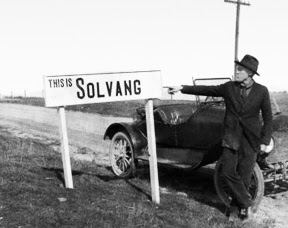Anyone traveling across California along Highway 246 will likely find an unexpected sight (unless they go looking for it). Just a few hours northeast of Santa Barbara, breaking up the Santa Ynez Valley farmland, is a small Danish village complete with four Danish-styled windmills.
While the town didn't always look Danish, the earliest area settlers were. They city was founded in 1911 on almost 10,000 acres with the specific intent to establish a Danish colony far away from Midwestern winters. The Danish-inspired architecture would come later, shortly after World War II.
Initially, three Danish immigrants raised money to buy land and then subdivide it into plots for farms, homes, and a small town center. Profits from the land sale would build a Danish-style folk school and, later, a Lutheran church. Settlers, mostly Danish, answered the call to create this new colony. The hotel opened in July 1911. The rest was a matter of time.
Solvang started as a farm community before becoming a tourist destination.
After the opening of the hotel, other businesses followed — a general store, creamery, bakery, bank, and butcher. Most of them were built to support the growing number of farmers who moved there, especially as irrigation systems were quickly developed and the area's first school opened.
Like many Danish schools, it was a "school of life." That meant it offered a broad range of courses, which included Dutch arts and dual languages. Within two years, Attedag College became the heart of the community (until it closed in 1952).
While the college eventually closed, the spirit of the Danish people did not. When the college helped the township celebrate its 25th anniversary, it created what became a predecessor to Danish Days. And Danish Days would later help inspire the concept of creating a Danish village in California.
After Word War II, Ferdinand Sorensen from Nebraska was the first to build a møllebakken (Danish-styled home) and the first village windmill. His work was followed up by local architect Earl Petersen, who began to add facades to existing buildings in order to give them a Danish Provincial look. And once this authentic Danish atmosphere took hold, it continued to grow into a vibrant tourist destination.
A small collection of ideas add to the Solvang experience.
One of the most obvious reasons to visit Solvang is to experience the abundance of shops and galleries that line the town's Danish-themed streets. More than 150 independent shop owners populate the stores, with an emphasis on arts and antiques. There are plenty of treats and eats too.
The more historic and interesting stops include the Elverhoj Museum of History and Art. The museum, which was once the handcrafted dream home of artist and sculptor Viggo Brandt-Erichsen and his wife Martha Mott, was converted to accommodate permanent and visiting exhibits.
Along with that popular museum, the town is also home to a small but interesting Hans Christian Andersen Museum above The Book Loft. It includes many artifacts that encapsulate his life and work. Along with that collection, Solvang is home to the Old Mission Santa Ines (an old Spanish Mission), Wildling Art Museum (American wilderness collection), and Mendenhall Museum (memorabilia).
The Solvang Motorcycle Museum is a must see, with one of the largest collections of vintage motorcycles and rare European racing bikes in North America. The models range from a 1910 FN to other rare and modern machines, with an emphasis on racing cycles. The collection is owned by Virgil Elings, who has been collecting them for more than two decades.
While most people drive in from other cities, there are more than a dozen resorts, hotels, and inns in Solvang. The Hadsten House is an affordable favorite with an on-site mini-vineyard, day spa, and European-styled rooms with decorative fireplaces.
For those looking for a richer experience, the Alisal Guest Ranch is a 10,000-acre getaway for those who enjoy horseback riding, fly-fishing, golf and tennis. The resort provides access to the beautiful Alisal Lake.
Solvang, California Blanks 7.8 On The Liquid Hip Richter Scale.
Solvang requires ample planning to ensure the experience includes more than a shopping stroll. The area is a prime location for wine tours and scenic bike rides. While there are many activities year round, Solvang is best known for its Julefest in December and Danish Days every September.
While Solvang is a great place to stay when taking in the village, especially guests who visit during the town's seasonal outdoor theatrical schedule, don't discount the abundance of hotels throughout the Santa Ynez Valley. For details and booking information, start by comparing specials against top travel deals at Expedia.com. Many people plan day trips to the village, but there are more opportunities to explore for those who stay several days.
![Liquid [Hip]](https://blogger.googleusercontent.com/img/b/R29vZ2xl/AVvXsEjAFBQPqS7J0-rrttNoRYSsuwIePPZf4Nq6sqDioK1zzVQXJIQXKzq_NVNI4n6h3inuRQFBKOcJeZeSufkdHHIOxbSWyBjTjTxgKEQGyPzdwvkEEeECh4bI5YEGk4RWGUINSd7vulPQsCA/s1600-r/liquidhip.jpg)


